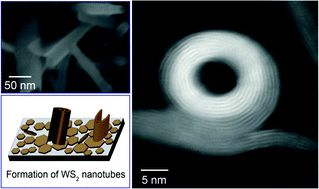Facile synthesis of WS2 nanotubes by sulfurization of tungsten thin films: formation mechanism, and structural and optical properties†
Abstract
While 2D layers of WS2 have been extensively studied, there are very few investigations of WS2 nanotubes. These have usually been grown via a 2-step process involving a WO3−x intermediate. We report a simple process for the synthesis of WS2 nanotubes via the sulfurization of tungsten films under appropriate conditions and present details of their structural and optical properties that help elucidate the formation mechanism. Electron-beam evaporated films of tungsten are sulfurized under flowing N2 gas at 950–1000 °C temperature under atmospheric pressure to obtain WS2 nanotubes. High-resolution scanning and transmission electron microscopy studies show that 2D WS2 flakes curl up and wrap around themselves to form nanotubes. Interlayer spacings in both ‘a’ and ‘c’ directions are slightly smaller than the corresponding values in bulk and thin film WS2. Micro-photoluminescence and micro-transmission studies show a resonance that seems intrinsic to the WS2 nanotubes since it cannot be related to the known optical characteristics of WS2 flakes.



 Please wait while we load your content...
Please wait while we load your content...